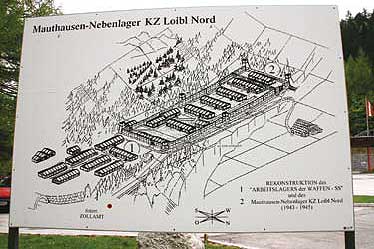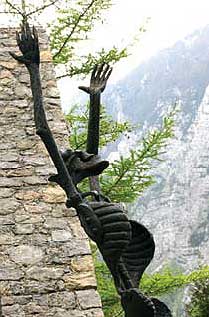Loibl Concentration Camp - A Laboratory of National Rememberance Culture
 The former concentration camp right at today's Austrian/Slovenian boarder used to be part of the concentration camp Mauthausen. From 1943 onwards prisoners had to slave at the Loibl Tunnel's gallery under inhumane circumstances. As the tunneling was undertaken from both sides simultaneously, part of the prisoners had to march northwards across the mountain pass on a daily basis for the first few months. As from autumn 1943 prisoners were moved to the newly built camp at the Loibl's northern face, which was even more feared than the camp at the southern face due to its worse weather conditions and even worse working conditions. On top of deathly forced labour, there was the SS guards' violence, who liked to torture the prisoners for their own amusement. Most of the time prisoners who were deemed unfit for work, were transported to Mauthausen to face certain death; many however were also murdered directly at Loibl concentration camp by an injection of gasoline into the heart. This murders were done by Sigbert Ramsauer. Despite all of this a resistance group emerged in the camp, which managed to smuggle messages to the outside. Time and again attempts to escape were successfull. Prisoners who could be freed mostly joined the resistance on their part.
The former concentration camp right at today's Austrian/Slovenian boarder used to be part of the concentration camp Mauthausen. From 1943 onwards prisoners had to slave at the Loibl Tunnel's gallery under inhumane circumstances. As the tunneling was undertaken from both sides simultaneously, part of the prisoners had to march northwards across the mountain pass on a daily basis for the first few months. As from autumn 1943 prisoners were moved to the newly built camp at the Loibl's northern face, which was even more feared than the camp at the southern face due to its worse weather conditions and even worse working conditions. On top of deathly forced labour, there was the SS guards' violence, who liked to torture the prisoners for their own amusement. Most of the time prisoners who were deemed unfit for work, were transported to Mauthausen to face certain death; many however were also murdered directly at Loibl concentration camp by an injection of gasoline into the heart. This murders were done by Sigbert Ramsauer. Despite all of this a resistance group emerged in the camp, which managed to smuggle messages to the outside. Time and again attempts to escape were successfull. Prisoners who could be freed mostly joined the resistance on their part.The physician Dr. Ramsauer was sentenced to life imprisonment by a British court martial in 1947, however was granted a reprieve as early as 1954 and was released. He opened a surgery in Klagenfurt/Celovec. Two SS men, Winkler and Briezke, were sentenced to death. Paul Gruschwitz, the commander of the northern camp was sentenced to 12 years. Karl Sachse, the rapport leader was sentenced to 20 years – both however were released as early as 1955.
These days Loibl concentration camp provides an extremely interesting opportunity of comparing Austria's remembrance culture with Slovenia's (former Yogoslavia respectively) remembrance culture: Whereas in the south, the former camp's grounds were preserved and a large, multilingual monument reminds of the former concentration camp, in the north only those can find traces of the camp, who know what they are looking for. As a result of the initiative shown by conserned individuals who also organise the yearly commemoration there are by now at least two large boards with sketches and explanatory notes behind the former customs house. The camp's grounds themselves however are still overgrown by forest. A small plaque at the tunnel entry reminds of the French and Polish forced labourers who were tortured and killed here.
